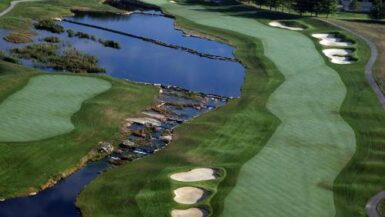
MONROE TOWNSHIP, NJ – Of the many accolades that our beloved Banks Course has earned since Stephen Kay’s masterful restoration,
perhaps none was more important than the glowing comments from no less a personage than Ran Morrissett himself, owner and operator of GolfClubAtlas.com, a world-wide think tank of experts on the topic of golf design.
As I took him wide-eyed with wonder around the venerable Banks Course it was clear tha he thought our course was both a marvel of architecture and a textbook example of the many template holes the Charles Banks loved to employ in defense of golf courses.
Morrissett was especially struck by our par-3s, which he both stated and wrote to us were as strong as the par-3s at venerable Pine Valley, perennially ranked the number one golf course in America. He also said they might be the best collection of par-3s at any Macdonald, Raynor, or Banks Course anywhere.
Every member’s heart should swell with pride at that. After all, it is true: We have the longest, toughest Eden hole in the country (perhaps even the world) at three. Our Redan (seven) is actually a Reverse Redan (more rare than the regular template) and has some of the most severe surrounds that the architectural bloodline of Macdonald Raynor and Banks ever designed in that type of hole. And of course our Short and our Biarritz (12 and 17) are museum quality examples of those holes, perfectly restored to their bold, exhilarating contours. Each par-3 is a precious jewel to be treasured in America’s golf architectural diadem.
Next, he was struck by the uniqueness of our Punchbowl at the 5th, with it’s cgarming surrounds, yet hurly-burly fairway tumbling over rugged terrain. Further, Morrissett exalted both our eighth and ninth holes. As we all know, those holes take your breath away, fairways rumbling over rugged, twisting terrain before finishing at greens dangerously perched above two of the most difficult bunkers anywhere in golf – twenty feet deep.
Morrissett also praised our finish – the charm of the short 15th, the brilliant greens at 16 and 17, – the couble plateau and the Biarritz – and the mighty 18th, a summation of all that came before. Indeed, he also noted to me that the collection of greens at the Banks course is as fine as any course in America.
Finally, we also have the distinction of being the swan song of Macdonald, Raynor, and Banks in America; only Tuckers Point in Bermuda was designed after Forsgate. It was as though Banks was saying farewell by giving us one last mighty crescendo with each hole.
Morrissett visited in order to write an in-depth article on the course for GolfClubAtlas.com, which should be on-line in two to three weeks. Morrissett’s delight at our course – which he called a marvel – will galvanize the rest of the golf world to want to come and see the Banks Course for themselves. Then the rest of the world will know what we’ve known since the day Chris Schiavone and Stephen Kay unveiled the masterful restoration: We have a regal pedigree of which we should be rightfully proud, and now the entire golf world knows it with adamantine certainty.




